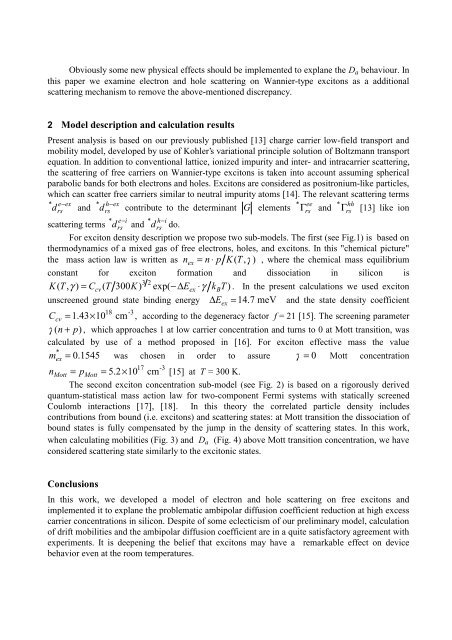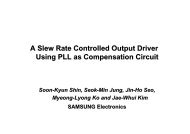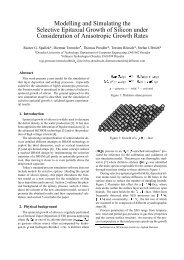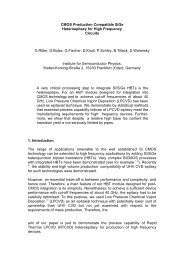Influence of Excitonic Scattering on Charge Carrier Ambipolar ... - Imec
Influence of Excitonic Scattering on Charge Carrier Ambipolar ... - Imec
Influence of Excitonic Scattering on Charge Carrier Ambipolar ... - Imec
Create successful ePaper yourself
Turn your PDF publications into a flip-book with our unique Google optimized e-Paper software.
Obviously some new physical effects should be implemented to explane the Da behaviour. In<br />
this paper we examine electr<strong>on</strong> and hole scattering <strong>on</strong> Wannier-type excit<strong>on</strong>s as a additi<strong>on</strong>al<br />
scattering mechanism to remove the above-menti<strong>on</strong>ed discrepancy.<br />
2 Model descripti<strong>on</strong> and calculati<strong>on</strong> results<br />
Present analysis is based <strong>on</strong> our previously published [13] charge carrier low-field transport and<br />
mobility model, developed by use <str<strong>on</strong>g>of</str<strong>on</strong>g> Kohler’s variati<strong>on</strong>al principle soluti<strong>on</strong> <str<strong>on</strong>g>of</str<strong>on</strong>g> Boltzmann transport<br />
equati<strong>on</strong>. In additi<strong>on</strong> to c<strong>on</strong>venti<strong>on</strong>al lattice, i<strong>on</strong>ized impurity and inter- and intracarrier scattering,<br />
the scattering <str<strong>on</strong>g>of</str<strong>on</strong>g> free carriers <strong>on</strong> Wannier-type excit<strong>on</strong>s is taken into account assuming spherical<br />
parabolic bands for both electr<strong>on</strong>s and holes. Excit<strong>on</strong>s are c<strong>on</strong>sidered as positr<strong>on</strong>ium-like particles,<br />
which can scatter free carriers similar to neutral impurity atoms [14]. The relevant scattering terms<br />
e ex<br />
drs − *<br />
h ex<br />
and drs − *<br />
* ee * hh<br />
c<strong>on</strong>tribute to the determinant G elements Γrs<br />
and Γrs<br />
[13] like i<strong>on</strong><br />
e i<br />
scattering terms drs − *<br />
h i<br />
and drs − *<br />
do.<br />
For excit<strong>on</strong> density descripti<strong>on</strong> we propose two sub-models. The first (see Fig.1) is based <strong>on</strong><br />
thermodynamics <str<strong>on</strong>g>of</str<strong>on</strong>g> a mixed gas <str<strong>on</strong>g>of</str<strong>on</strong>g> free electr<strong>on</strong>s, holes, and excit<strong>on</strong>s. In this "chemical picture"<br />
the mass acti<strong>on</strong> law is written as nex = n ⋅ p K(<br />
T,<br />
γ ) , where the chemical mass equilibrium<br />
c<strong>on</strong>stant for excit<strong>on</strong> formati<strong>on</strong> and dissociati<strong>on</strong> in silic<strong>on</strong> is<br />
3 2<br />
K( T,<br />
γ ) = Ccv(<br />
T 300K<br />
) exp( −ΔEex<br />
⋅γ<br />
kBT<br />
) . In the present calculati<strong>on</strong>s we used excit<strong>on</strong><br />
unscreened ground state binding energy E = 14.<br />
7 meV and the state density coefficient<br />
18 -3<br />
cm<br />
Δ ex<br />
C cv = 1 . 43×<br />
10 , according to the degeneracy factor f = 21 [15]. The screening parameter<br />
γ ( n + p)<br />
, which approaches 1 at low carrier c<strong>on</strong>centrati<strong>on</strong> and turns to 0 at Mott transiti<strong>on</strong>, was<br />
calculated by use <str<strong>on</strong>g>of</str<strong>on</strong>g> a method proposed in [16]. For excit<strong>on</strong> effective mass the value<br />
m 0.<br />
1545 was chosen in order to assure γ = 0 Mott c<strong>on</strong>centrati<strong>on</strong><br />
* =<br />
ex<br />
17 -3<br />
cm<br />
n Mott = pMott<br />
= 5 . 2×<br />
10 [15] at T = 300 K.<br />
The sec<strong>on</strong>d excit<strong>on</strong> c<strong>on</strong>centrati<strong>on</strong> sub-model (see Fig. 2) is based <strong>on</strong> a rigorously derived<br />
quantum-statistical mass acti<strong>on</strong> law for two-comp<strong>on</strong>ent Fermi systems with statically screened<br />
Coulomb interacti<strong>on</strong>s [17], [18]. In this theory the correlated particle density includes<br />
c<strong>on</strong>tributi<strong>on</strong>s from bound (i.e. excit<strong>on</strong>s) and scattering states: at Mott transiti<strong>on</strong> the dissociati<strong>on</strong> <str<strong>on</strong>g>of</str<strong>on</strong>g><br />
bound states is fully compensated by the jump in the density <str<strong>on</strong>g>of</str<strong>on</strong>g> scattering states. In this work,<br />
when calculating mobilities (Fig. 3) and Da (Fig. 4) above Mott transiti<strong>on</strong> c<strong>on</strong>centrati<strong>on</strong>, we have<br />
c<strong>on</strong>sidered scattering state similarly to the excit<strong>on</strong>ic states.<br />
C<strong>on</strong>clusi<strong>on</strong>s<br />
In this work, we developed a model <str<strong>on</strong>g>of</str<strong>on</strong>g> electr<strong>on</strong> and hole scattering <strong>on</strong> free excit<strong>on</strong>s and<br />
implemented it to explane the problematic ambipolar diffusi<strong>on</strong> coefficient reducti<strong>on</strong> at high excess<br />
carrier c<strong>on</strong>centrati<strong>on</strong>s in silic<strong>on</strong>. Despite <str<strong>on</strong>g>of</str<strong>on</strong>g> some eclecticism <str<strong>on</strong>g>of</str<strong>on</strong>g> our preliminary model, calculati<strong>on</strong><br />
<str<strong>on</strong>g>of</str<strong>on</strong>g> drift mobilities and the ambipolar diffusi<strong>on</strong> coefficient are in a quite satisfactory agreement with<br />
experiments. It is deepening the belief that excit<strong>on</strong>s may have a remarkable effect <strong>on</strong> device<br />
behavior even at the room temperatures.











